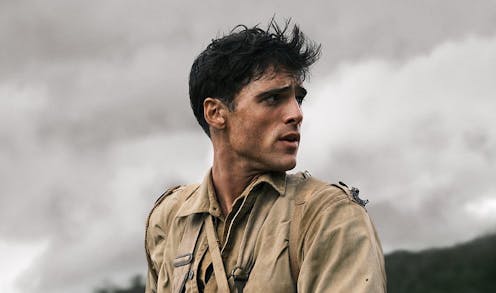‘Ambitious’ or ‘pretentious’? The contested legacy of Richard Flanagan’s The Narrow Road to the Deep North
- Written by Luke Johnson, Senior Lecturer in Creative Writing, University of Wollongong

In 2018, it was announced that Richard Flanagan’s Man Booker Prize-winning novel The Narrow Road to the Deep North (2013) would be made into a “high-end drama series” by FremantleMedia. Jo Porter, Fremantle’s director of drama, called the novel “ripe for screen adaptation with huge visual potential and scale”. A somewhat more circumspect Flanagan referred to “the depth and the occasional brilliance of which the form [television] is now capable”. My italics.
Whether or not these screen aspirations come to pass will be known on April 18, when the first episode airs on Prime. If you’ve clicked on this article hoping for an early verdict or a bit of insider goss, you’ll be disappointed to learn that I have vowed not to give anything away until then. Which will be easy for me, because I haven’t seen it yet.
So what am I doing here then? Getting you all excited about a series you’ve been pining for since former prime minister Tony Abbott shirtfronted the 2014 Prime Minister’s Literary Award committee with one of his classic “captain’s picks”, naming Narrow Road the joint winner alongside the committee’s preferred choice, Steven Carroll’s A World of Other People?
Well, I’m here to remind you that “at the beginning of things there is always light”. So begins Flanagan’s novel: a light-filled, dust-mote-swirling tribute to his father, who spent three years in a Japanese prisoner-of-war camp during the second world war.
Along with 13,000 other Australians, Flanagan’s father was put to work on the infamous Thai-Burma “death” railway. This 12-month railroad project was to claim the lives of more than 90,000 Asian civilians and 16,000 prisoners, including 2,800 Australians. It has since “entered the Australian consciousness as a byword for courage and resilience in the face of extreme hardship”.
Flanagan drew criticism from Australian critic Roger Pulvers in an early review of the book, for “giving the impression it was mostly Australians who died constructing the Death Railroad”. Given his proximity to the story, the author can probably be forgiven for such narratorial decisions. Narrow Road is the story Flanagan said he “never wanted to write”, but which, after 12 years and five different versions, accepted he “had to write”. His father passed away the night he completed the final draft.
In the decade since, the novel has been extensively reviewed, anecdotes like the one above have been worked into numerous profile pieces, and Flanagan’s status as a major Australian writer has been conferred by dozens of book clubs the country over. It is safe to assume the television series will not only please longtime fans, but draw new cohorts of readers to his book.
With this in mind, it is worth revisiting the novel to see just how well it fares in 2025. What are its enduring legacies? Do its depictions of valour and heroism continue to resonate in an age of renewed military aggression? Are its literary controversies behind it? The now-deceased poet Les Murray responded to Abbott’s intervention by labelling Narrow Road a “pretentious and stupid book”. Has Murray had the last, full-bellied laugh?
Before, during, after
The Narrow Road to the Deep North is broken into sections that roughly equate to before, during and after internment, with a lot of time-jumping in between and around the margins.
For my money, it’s the “during” section that works best on the page, with its mythologies of mateship and its visceral poetics doing what they’ve been doing since an avenging Achilles circled the walls of Troy with Hector’s body in tow. Longstanding staples of the genre they may be, but effective and affective they remain.
The novel’s protagonist, Alwyn “Dorrigo” Evans, is based in part on real-life war hero and surgeon Edward “Weary” Dunlop, who was among the first Australian prisoners sent to work on the railway in 1943. He remained there until the end of the war, “labouring tirelessly to save wounded, sick and malnourished men”.
But as the “after” section of Narrow Road reveals, Dorrigo Evans is also part Ulysses, of the Tennysonian variety. He is a man who arrives home from his perilous voyages “a part of all that [he has] met” along the way, and deeply depressed by the dullness of having to pause now “to make an end”.
In the novel, this dullness comes in the form of loyal but passionless love, otherwise known as marriage. Dorrigo spends the postwar decades doing his best to rekindle the memory of his pre-war affair with his uncle’s younger wife, Amy – the only woman he has ever properly desired. But nothing he does (or rather, nobody he does) quite gets him there.
In this regard, Dorrigo is a classic flawed hero. He is an immovable pillar of emotional support for the allied soldiers dying around him in the choleric jungles of Thailand. But he is an absent father and adulterous husband to the family who crave his love and attention in the ensuing quiet years back home.
Suffering myths
How we commemorate conflict and to what end we employ the archetypes born therein has a lot to do with the way we view ourselves as a nation. As historian Joan Beaumont puts it:
The memory of war has played a prominent role in Australia’s political culture since the Gallipoli campaign of 1915 gave birth to the ‘Anzac legend’, a mythologised account of the character and performance of the citizen soldier that endures to this day as a signifier of national identity.
Since the release of Peter Weir’s 1981 cinematic masterpiece commemorating the Gallipoli campaign, the predominant story told of Australian soldiers, on page and screen, has been one of suffering and sacrifice.





